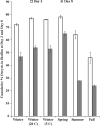Seasonal retention and release of Cryptosporidium parvum oocysts by environmental biofilms in the laboratory
- PMID: 20023100
- PMCID: PMC2820982
- DOI: 10.1128/AEM.01804-09
Seasonal retention and release of Cryptosporidium parvum oocysts by environmental biofilms in the laboratory
Abstract
Cryptosporidium is a genus of waterborne protozoan parasites that causes significant gastrointestinal disease in humans. These parasites can accumulate in environmental biofilms and be subsequently released to contaminate water supplies. Natural microbial assemblages were collected each season from an eastern Pennsylvania stream and used to grow biofilms in laboratory microcosms in which influx, efflux, and biofilm retention were determined from daily oocyst counts. For each seasonal biofilm, oocysts attached to the biofilm quickly during oocyst dosing. Upon termination of oocyst dosing, the percentage of oocysts retained within the biofilm decreased to a new steady state within 5 days. Seasonal differences in biofilm retention of oocysts were observed. The spring biofilm retained the greatest percentage of oocysts, followed (in decreasing order) by the winter, summer, and fall biofilms. There was no statistically significant correlation between the percentage of oocysts attached to the biofilm and (i) any measured stream water quality parameter (including temperature, pH, conductivity, and dissolved organic carbon concentration) or (ii) experimental temperature. Seasonal differences in oocyst retention persisted when biofilms were tested with stream water from a different season. These data suggest that seasonal variation in the microbial community and resulting biofilm architecture may be more important to oocyst transport in this stream site than water quality. The biofilm attachment and detachment dynamics of C. parvum oocysts have implications for public health, and the drinking water industry should recognize that the potential exists for pathogen-free water to become contaminated during the distribution process as a result of biofilm dynamics.
Figures





Similar articles
-
Pseudo-Second-Order Calcium-Mediated Cryptosporidium parvum Oocyst Attachment to Environmental Biofilms.Appl Environ Microbiol. 2016 Dec 15;83(1):e02339-16. doi: 10.1128/AEM.02339-16. Print 2017 Jan 1. Appl Environ Microbiol. 2016. PMID: 27793825 Free PMC article.
-
Biofilm roughness determines Cryptosporidium parvum retention in environmental biofilms.Appl Environ Microbiol. 2012 Jun;78(12):4187-93. doi: 10.1128/AEM.08026-11. Epub 2012 Apr 6. Appl Environ Microbiol. 2012. PMID: 22492449 Free PMC article.
-
Biofilm Sampling for Detection of Cryptosporidium Oocysts in a Southeastern Pennsylvania Watershed.Appl Environ Microbiol. 2020 Nov 10;86(23):e01399-20. doi: 10.1128/AEM.01399-20. Print 2020 Nov 10. Appl Environ Microbiol. 2020. PMID: 32978132 Free PMC article.
-
Cryptosporidium-Biofilm Interactions: a Review.Appl Environ Microbiol. 2021 Jan 15;87(3):e02483-20. doi: 10.1128/AEM.02483-20. Print 2021 Jan 15. Appl Environ Microbiol. 2021. PMID: 33187998 Free PMC article. Review.
-
Biology, persistence and detection of Cryptosporidium parvum and Cryptosporidium hominis oocyst.Water Res. 2004 Feb;38(4):818-62. doi: 10.1016/j.watres.2003.10.012. Water Res. 2004. PMID: 14769405 Review.
Cited by
-
Effect of Glycosaminoglycans on Cryptosporidium Oocyst Attachment and Excystation.Appl Environ Microbiol. 2023 Mar 29;89(3):e0173722. doi: 10.1128/aem.01737-22. Epub 2023 Feb 15. Appl Environ Microbiol. 2023. PMID: 36790186 Free PMC article.
-
Pseudo-Second-Order Calcium-Mediated Cryptosporidium parvum Oocyst Attachment to Environmental Biofilms.Appl Environ Microbiol. 2016 Dec 15;83(1):e02339-16. doi: 10.1128/AEM.02339-16. Print 2017 Jan 1. Appl Environ Microbiol. 2016. PMID: 27793825 Free PMC article.
-
Calcium-Mediated Biophysical Binding of Cryptosporidium parvum Oocysts to Surfaces Is Sensitive to Oocyst Age.Appl Environ Microbiol. 2019 Aug 14;85(17):e00816-19. doi: 10.1128/AEM.00816-19. Print 2019 Sep 1. Appl Environ Microbiol. 2019. PMID: 31253676 Free PMC article.
-
Extracellular excystation and development of Cryptosporidium: tracing the fate of oocysts within Pseudomonas aquatic biofilm systems.BMC Microbiol. 2014 Nov 18;14:281. doi: 10.1186/s12866-014-0281-8. BMC Microbiol. 2014. PMID: 25403949 Free PMC article.
-
Role of Wall Shear Stress in Cryptosporidium parvum Oocyst Attachment to Environmental Biofilms.Appl Environ Microbiol. 2017 Dec 1;83(24):e01533-17. doi: 10.1128/AEM.01533-17. Print 2017 Dec 15. Appl Environ Microbiol. 2017. PMID: 29030438 Free PMC article.
References
-
- Christensen, B. B., C. Sternberg, J. B. Anderson, R. J. Palmer, A. T. Nielsen, M. Givskov, and S. Molin. 1999. Molecular tools for study of biofilm physiology. Methods Enzymol. 310:20-42. - PubMed
-
- Dai, X., and R. M. Hozalski. 2002. Effect of NOM and biofilm on the removal of Cryptosporidium parvum oocysts in rapid filters. Water Res. 36:3523-3532. - PubMed
-
- Drury, W. J., W. G. Characklis, and P. S. Stewart. 1993. Interactions of 1-μm latex particles with Pseudomonas aeruginosa biofilms. Water Res. 27:1119-1126. - PubMed
Publication types
MeSH terms
LinkOut - more resources
Full Text Sources

